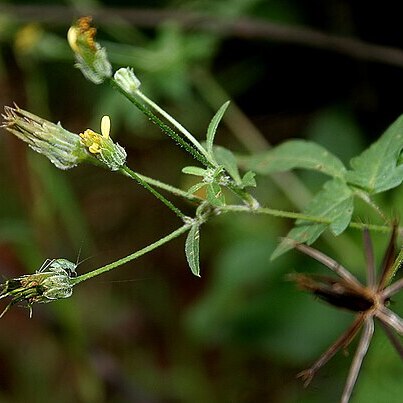Annual herb, erect, 0.1-2 m high; stem reddish tinged, 4-angled, simple or branched, pubescent or glabrous. Leaves opposite or rarely alternate near the apex, broadly ovate in outline, pinnately (3-)5-9-lobed or almost pinnatisect, 3-20 cm long, 2.5-12 cm wide, leaf segments ovate to lanceolate, lobed or bilobed at base, margins crenate-serrate to almost lobulate, apices acute; petiole to 60 mm long. Capitula in terminal lax paniculate cymes; involucre cup-shaped; outer phyllaries 4-8(-15), linear to oblanceolate, 4-6(-12) mm long, to 20 mm long in fruit, pubescent, inner phyllaries 8-11, yellowish green, with paler margins, 3.5-7 mm long, pubescent; paleae 4.5-6 mm long. Ray florets yellow, rarely orange, neuter or with staminodes, (1-)2-5, tube 0.8-1.3 mm long, pubescent, rays 3-6 x 1.3-2.5 mm, striate; disc florets yellow to orange-yellow, 3-3.7 mm long, glabrous. Achenes black, 4-8-ribbed, linear-tetragonal, 6-16(-25) mm long, strigose in upper half; aristae (2-)3-4(-5), yellow-brown, 2-4 mm long, retrorsely barbed.
Annuals. Stems erect, 30-150 cm tall, subtetragonal, loosely crisp pilose, branched in upper portion. Leaves cauline; median leaves opposite, petiole 3-5 cm, blade 9-15 cm, prominently soft pubescent on both surfaces, once or twice divided into pinnate leaflets, terminal segment ovate, shortly acuminate, rather prominently toothed, lateral segments ovate, sometimes lower one pinnatifid; upper leaves gradually smaller, opposite or alternate, bipinnately parted. Capitula radiate or discoid, 7-10 mm in diam.; peduncle 1.5-5.5 cm; phyllaries 8-10, 1-seriate, herbaceous, linear, 3-6.5 mm, acute; outer chaff calycular bracts 5-6 mm, margin hyaline. Ray florets 0-5, sterile; lamina yellow, ca. 5.5 × 2.5-3 mm, tube 1.2-1.5 mm. Disk florets bisexual, fertile; corolla 4-5.5 mm, tube 1.2-2 mm. Achenes linear, 9-19 × ca. 1 mm, compressed, 4-angled, shortly strigose; pappus awns 3 or 4, 3-4 mm. Fl. Sep-Nov.
Annual herb, up to 2 m high. Leaves opposite, rarely alternate towards apex; blade broadly ovate in outline, up to 200 mm long, 5-9-pinnately lobed or pinnatisect, leaflets ovate, basal pair ± deeply divided into 2 asymmetric lobes, margins serrate, glabrous or pilose; petiole up to 60 mm long. Heads radiate, up to 10 mm in diameter, in lax, paniculate cymes, pedunculate. Involucral bracts biseriate, imbricate, pubescent. Receptacle paleate. Flowers: ray florets small, neuter, yellow; disc florets bisexual, yellow; Jan. Fruit with cypsela black, linear-tetragonal, hispid towards apex. Pappus of 3 or 4(5) awns.
A small erect annual herb. It grows about 1 m high. It is branched. The stems are angular with furrows and some hairs. The stems are tough. The leaves are opposite with one or two pairs of leaflets and one at the edge. The leaflets at the base are lobed and have rounded teeth. They are hairy on both sides. They are yellowish green and lighter underneath. They are 2-7 cm long by 1-4 cm wide. The flowers are at the top of the plant. The flowers are in disk like heads. The flowers are yellow. The fruit has 3 or 4 bristles at the end.
Annual herb, 0.4-1.5 m high; branching, stems sometimes decumbent at base and rooting. Leaves glabrous or pilose, pinnate, base cuneate, apex acute to acuminate, margins crenate-serrate. Capitula in lax, few-headed corymbs; involucral bracts oblong or subspathulate. Ray florets 2-4, yellow. Disc florets yellow. Cypselae linear, angled, ribbed, slightly dimorphic.
Annual herb, up to 1.5 m high. Leaves once pinnate with (3-)5-9 narrowly ovate to ovate leaflets, basal pair ± deeply divided into 2 asymmetric lobes. Pappus awns 3 or 4(5). Flowers yellow.
An annual weedy herb
Yellow flowers.

